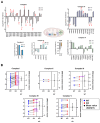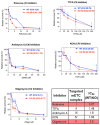Proteomic Analysis of ARID1A-Deficient Ovarian Clear Cell Carcinoma Cells Reveals Differential Mitochondria ETC Subunit Abundances and Targetable Mitochondrial Pathways
- PMID: 40564930
- PMCID: PMC12193532
- DOI: 10.3390/ijms26125466
Proteomic Analysis of ARID1A-Deficient Ovarian Clear Cell Carcinoma Cells Reveals Differential Mitochondria ETC Subunit Abundances and Targetable Mitochondrial Pathways
Abstract
ARID1A-deficient ovarian clear cell carcinoma is a highly lethal gynecologic cancer that depends heavily on mitochondrial respiration. Our biochemical and proteomic analyses reveal that ARID1A knockout cells exhibit marked upregulation of specific subunits within mitochondrial electron transport chain (ETC) Complexes I, III, and IV. However, this upregulation does not directly translate into increased sensitivity to broad-spectrum inhibitors targeting these complexes. These findings suggest that broad-spectrum mitochondrial inhibitors may not be effective therapeutic options for ARID1A-deficient cancers. Instead, the selective inhibition of specific ETC subunits may offer a more promising approach to exploit the metabolic vulnerabilities of ARID1A-deficient cells.
Keywords: ARID1A; electron transport chain; mitochondria; ovarian clear cell carcinoma; proteomics.
Conflict of interest statement
The authors declare no conflicts of interest.
Figures




Similar articles
-
Targeting Mitochondrial Metabolism in Clear Cell Carcinoma of the Ovaries.Int J Mol Sci. 2021 Apr 29;22(9):4750. doi: 10.3390/ijms22094750. Int J Mol Sci. 2021. PMID: 33947138 Free PMC article.
-
Therapeutic preferability of gemcitabine for ARID1A-deficient ovarian clear cell carcinoma.Gynecol Oncol. 2019 Dec;155(3):489-498. doi: 10.1016/j.ygyno.2019.10.002. Epub 2019 Oct 8. Gynecol Oncol. 2019. PMID: 31604667
-
The Primary Effect on the Proteome of ARID1A-mutated Ovarian Clear Cell Carcinoma is Downregulation of the Mevalonate Pathway at the Post-transcriptional Level.Mol Cell Proteomics. 2016 Nov;15(11):3348-3360. doi: 10.1074/mcp.M116.062539. Epub 2016 Sep 21. Mol Cell Proteomics. 2016. PMID: 27654507 Free PMC article.
-
Impact of residual disease as a prognostic factor for survival in women with advanced epithelial ovarian cancer after primary surgery.Cochrane Database Syst Rev. 2022 Sep 26;9(9):CD015048. doi: 10.1002/14651858.CD015048.pub2. Cochrane Database Syst Rev. 2022. PMID: 36161421 Free PMC article.
-
The Molecular Mechanisms of Actions, Effects, and Clinical Implications of PARP Inhibitors in Epithelial Ovarian Cancers: A Systematic Review.Int J Mol Sci. 2022 Jul 23;23(15):8125. doi: 10.3390/ijms23158125. Int J Mol Sci. 2022. PMID: 35897700 Free PMC article.
References
-
- Berns K., Caumanns J.J., Hijmans E.M., Gennissen A.M.C., Severson T.M., Evers B., Wisman G.B.A., Jan Meersma G., Lieftink C., Beijersbergen R.L., et al. ARID1A mutation sensitizes most ovarian clear cell carcinomas to BET inhibitors. Oncogene. 2018;37:4611–4625. doi: 10.1038/s41388-018-0300-6. - DOI - PMC - PubMed
-
- Katagiri A., Nakayama K., Rahman M.T., Rahman M., Katagiri H., Nakayama N., Ishikawa M., Ishibashi T., Iida K., Kobayashi H., et al. Loss of ARID1A expression is related to shorter progression-free survival and chemoresistance in ovarian clear cell carcinoma. Mod. Pathol. 2012;25:282–288. doi: 10.1038/modpathol.2011.161. - DOI - PubMed
MeSH terms
Substances
Grants and funding
LinkOut - more resources
Full Text Sources
Medical

